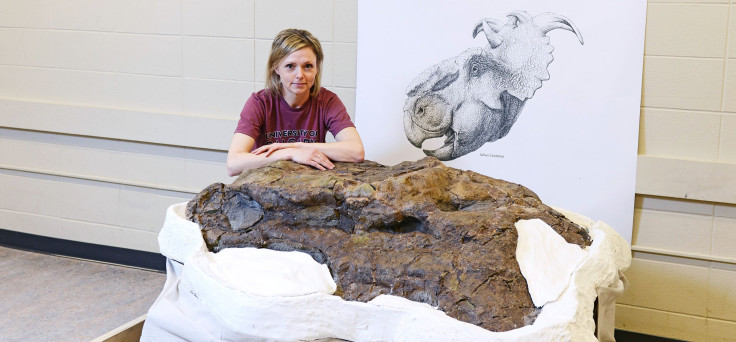70 Million-Year-Old Dinosaur Skull Found In Canada, Rare Fossil May Belong To Mature Pachyrhinosaur [PHOTO]

The 70 million-year-old skull of a horned dinosaur was discovered in Alberta, Canada, scientists said Thursday.
They've determined the skull is that of a large pachyrhinosaur. Measuring six feet in length, the skull took more than 10 days to extract from five to six tons of rock in the Alberta Badlands. The last time a similar discovery was made in the region was 50 years ago, when only a partial skull was recovered.
“It is very rare to find such a complete skull specimen of this size and type in the region,” Darla Zelenitsky, assistant professor at the University of Calgary and a research assistant, said in a statement. “Based on our preliminary estimates, the dinosaur’s head would have been well over two metres long and was likely of a mature or older individual. The skull of this animal has an enormous bony structure over the snout that would have made for a very strange-looking individual.”
Researchers were doing a routine fossil search when they stumbled upon a small bumpy rock that turned out to be the skull.
Pachyrhinosaurs were four-legged herbivores that roamed modern Alberta and Alaska about 70 million years ago. Measuring up to 19 feet in length, its head has large bony bumps, horns and a frill that extended over its neck – features that may have played a part in mating or combat.
Initial findings point to the skull belonging to a mature pachyrhinosaur – a rare find. "From the Drumheller area, there's very few pachyrhinosaur skulls that have been collected. There was part of one that was collected over 50 years ago, so this is the first one in 50 years, and we've got a good portion — probably 75 to 80 percent of it," Zelenitsky told the Canadian Press.
Once the skull is cleaned, researchers plan to study it further.
“Our initial goal will be to determine if this specimen represents a new species,” Zelenitsky said. “Following that, the specimen will be measured and scanned to help document how the skull of pachyrhinosaurs changed during growth, particularly in the later stages of life. The nature of this discovery will certainly add to our understanding of the biology of pachyrhinosaurs.”
© Copyright IBTimes 2024. All rights reserved.






















